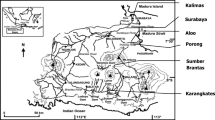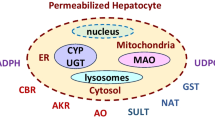Summary
Primary cultures of fish hepatocytes have been used as a convenient model for studies on cytochrome expression. Here we have further examined the regulation of CYP enzymes in this model. A transient increase in CYP1A1 messenger ribonucleic acid (mRNA) and 7-ethoxyresorufin-O-deethylase (EROD) activity occurred within h after medium change. This event implies that either an exogenous, quickly metabolized CYP1A1 inducer was introduced to the hepatocytes with the fresh medium, or that the mechanical act of changing the medium disrupts the cell homeostasis, which in turn activates CYP1A1 transcription or alternatively stabilizes CYP1A1 mRNA. CYP1A1 has been shown to be highly inducible in primary cultures of rainbow trout hepatocytes by 2,3,7,8-tetrachlorodibenzo-p-dioxin (TCDD) via an aryl hydrocarbon (Ah) receptor-mediated activation of gene transcription. In the present study, CYP1A1 was strongly induced by TCDD, whereas CYP2K1, a constitutively expressed cytochrome P450 (CYP), was refractory to the same treatment. Cycloheximide efficiently blocked protein synthesis in the cell culture, and thus the apparent half-life of CYP1A1 (measured as EROD activity) could be estimated. In cells treated with TCDD for 24 h the CYP1A1 apparent half-life was estimated to be 15.9 h. When ethoxycoumarin-O-deethylase activity was used as an indicator of CYP levels, a considerably longer half-life of 27.1 h was estimated. The level of CYP2K1 remained constant throughout the study and was not sensitive to cycloheximide exposure (30 h), indicating a considerably longer half-life of this protein in cell culture.
Similar content being viewed by others
References
Abnet, C. C.; Tanguay, R. L.; Hahn, M. E.; Heideman, W.; Peterson, R. E. Two forms of aryl hydrocarbon receptor type 2 in rainbow trout (Oncorhynchus mykiss). Evidence for differential expression and enhancer specificity. J. Biol. Chem. 274:15,159–15,166; 1999.
Andersson, T.; Förlin, L. Spectral properties of substrate-cytochrome P-450 interaction and catalytic activity of xenobiotic metabolizing enzymes in isolated rainbow trout liver cells. Biochem. Pharmacol. 34:1407–1413: 1985.
Andersson, T.; Förlin, L. Regulation of the cytochrome P450 enzyme system in fish. Aquat. Toxicol. 24:1–20; 1992.
Baksi, S. M.; Frazier, J. M. Isolated fish hepatocytes—model system for toxicology research. Aquat. Toxicol. 16:256–299; 1990.
Berndtson, A. K.; Chen, T. T.: Two unique CYP1 genes are expressed in response to 3-methylcholanthrene treatment in rainbow trout. Arch. Biochem. Biophys. 310:187–195; 1994.
Berry, M. N.; Friend, D. S. High-yield preparation of isolated rat liver parenchymal cells. A biochemical and fine structural study. J. Cell. Biol. 43:506–520; 1969.
Boobis, A. R.; Whyte, C.; Davies, D. S. Selective induction and inhibition of the components of 7-ethoxycoumarin O-deethylase activity in the rat. Xenobiotica 16:233–238; 1986.
Buhler, D. R.; Miranda, C. L.; Deinzer, M. L.; Griffin, D. A.; Henderson, M. C. The regiospecific hydroxylation of lauric acid by rainbow trout (Oncorhynchus mykiss) cytochrome P450s. Drug Metab. Dispos. 25:1176–1183; 1997.
Buhler, D. R.; Yang, Y.-H.; Dreher, T. W.; Miranda, C. L.; Wang, J.-L. Cloning and sequencing of the major rainbow trout constitutive cytochrome P450 (CYP2K1): identification of a new cytochrome P450 gene subfamily and its expression in mature rainbow trout liver and trunk kidney. Arch. Biochem. Biophys. 312:45–51; 1994.
Burke, M. D.; Mayer, R. T. Ethoxyresorufin: direct fluorometric assay of a microsomal-O-dealkylation which is preferentially inducible by 3-methylcholanthrene. Drug Metab. Dispos. 2:583–588; 1974.
Collier, T. K.; Singh, V. S.; Awasthi, Y. C.; Varanasi, U.; Heopatic xenobiotic metabolizing enzymes in two species of benthic fish showing different prevalences of contaminant-associated liver neoplasms. Toxicol. Appl. Pharmacol. 113:319–324; 1992.
Chomczynski, P. The RNAzol® B method. Tel-Test Inc. Bulletin No. 3, 1989.
Chomczynski, P.; Sacchi, N. Single-step method of RNA isolation by acid guanidinium thiocyanate-phenol-chloroform extraction. Anal. Biochem. 162:156–159; 1987.
Förlin, L. The cytochrome P-450 system in fish, aquatic toxicology and environmental monitoring. Aquat. Toxicol. 22:287–312; 1992.
Guengerich, F. P. Roles of cytochrome P-450 enzymes in chemical carcinogens and cancer chemotherapy. Cancer Res. 48:2946–2954; 1988.
Hightower, L. E.; Renfro, J. L. Recent applications of fish cell culture to biomedical research. J. Exp. Zool. 248:290–302; 1988.
Huff, J.; Lucier, G.; Tritscher, A.: Carcinogenicity of TCDD: experimental, mechanistic, and epidemiologic evidence. Ann. Rev. Pharmacol. Toxicol. 34:343–372; 1994.
Kimura, S.; Gonzalez, F. J.; Nebert, D. W. Tissue-specific expression of the mouse dioxin-inducible P1450 and P3450 genes: differential transcriptional activation and mRNA stability in liver and extrahepatic tissues. Mol. Cell. Biol. 6:1471–1477; 1986.
Kloepper-Sams, P. J.; Stegeman, J. J. Turnover of hepatic microsomal cytochrome P4501A protein and heme in β-naphthoflavone-induced Fundulus heteroclitus. Mol. Mar. Biol. Biotechnol. 3:171–183; 1994.
Klotz, A. V.; Stegeman, J. J.; Walsh, C. An aryl hydrocarbon hydroxylating hepatic cytochrome P-450 from the marine fish Stenotomus chrysops. Arch. Biochem. Biophys. 226:578–592.
Kocarek T. A.; Schuetz, E. G.; Guzelian, P. S. Transient induction of cytochrome P450 1A1 mRNA by culture medium component in primary cultures of adult rat hepatocytes. In Vitro Cell. Dev. Biol. 29A:62–66; 1993.
Lockwood, A. P. M. “Ringer” solutions and some notes on the physiogical basis of their ionic composition. Comp. Biochem. Physiol. 2:241–289; 1961.
Lorenzen, A.; Okey, A. B. Detection and characterization of [3H]2,3,7,8-tetrachlorodibenzo-p-dioxin binding to Ah receptor in a rainbow trout hepatoma cell line. Toxicol. Appl. Pharmacol. 106:53–62; 1990.
Lowry, O. H.; Rosebrough, N. J.; Farr, A. L.; Randall, R. J. Protein measurements with Folin phenol reagent. J. Biol. Chem. 193:265–275; 1951.
Mufti, N. A.; Bleckwenn, N. A.; Babish, J. G.; Shuler, M. L. Possible involvement of the Ah receptor in the induction of cytochrome P-450IA1 under conditions of hydrodynamic shear in microcarrier-attached hepatoma cell lines. Biochem. Biophys. Res. Commun. 208:144–152; 1995.
Nebert, D. W.; Nelson, D. R.; Coon, M. J., et al. The P450 superfamily: update on new sequences, gene mapping, and recommended nomenclature. DNA Cell Biol. 10:1–14; 1991.
Nemoto, N.; Sakurai, J. Increase of CYP1A1 mRNA and AHH activity by inhibitors of either protein or RNA synthesis in mouse hepatocytes in primary culture. Carcinogenesis 12:2115–2121; 1991.
Okey, A. B.; Riddick, D. S.; Harper, P. A. Molecular biology of the aromatic hydrocarbon (dioxin) receptor. Trends Plant Sci. 15:226–232; 1994.
Omiecinski, C. J.; Remmel, R. P.; Hosagrahara, V. P. Concise review of the cytochrome P450s and their roles in toxicology. Toxicol. Sci. 48:151–156; 1999.
Padgham, C. R. W.; Paine, A. J. Altered expression of cytochrome P-450 mRNAs, and potentially of other transcripts encoding key hepatic functions, are triggered during isolation of rat hepatocytes. Biochem. J. 289:621–624; 1993.
Pasco, D. S.; Boyum, K. W.; Merchant, S. N.; Chalberg, S. C.; Fagan, J. B. Transcriptional and post-transcriptional regulation of the genes encoding cytochromes P-450c and P-450d in vivo and in primary hepatocyte cultures. J. Biol. Chem. 263:8671–8676; 1988.
Pesonen, M.; Andersson, T. Characterization and induction of xenobiotic metabolizing enzyme activities in a primary culture of rainbow trout hepatocytes. Xenobiotica 21:461–471; 1991.
Petersen, D. D.; McKinney, C. E.; Ikeya, K.; Smih H. H.; Bale, A. E.; McBride, O. W.; Nebert, D. W. Human CYP1A1 gene: cosegregration of the enzyme inducibility phenotype and RFLP. Am. J. Hum. Genet. 48:720–725; 1991.
Peterson, R. E.; Theobald, H. M.; Kimmel, G. L. Developmental and reproductive toxicity of dioxins and related compounds: cross-species comparisons. Crit. Rev. Toxicol. 23:283–335; 1993.
Sadar, M. D.; Ash, R.; Sunqvist, J.; Olsson, P.-E.; Andersson, T. B. Phenobarbital induction of CYP1A1 gene expression in a primary culture of rainbow trout hepatocytes. J. Biol. Chem. 271:17,636–17,643; 1996.
Sadek, C. M.; Allen-Hoffmann, B. L. Cytochrome P450IA1 is rapidly induced in normal human keratinocytes in the absence of xenobiotics. J. Biol. Chem. 269:16,067–16,074; 1994.
Scholz, S.; Segner H. Induction of CYP1A in primary cultures of rainbow trout (Oncorhynchus mykiss) liver cells: concentration-response relationships of four model substances. Ecotoxicol. Environ. Safety 43:252–260; 1999.
Schwarz, L. R.; Wiebel, F. J. Cytochrome P450 in primary and permanent liver cell cultures. In: Schenkman, J. B.; Greim, H., ed. Cytochrome P450. Handbook of experimental pharmacology. Vol. 105. London: Springer; 1993:399–413.
Shiraki, H.; Guengerich, F. P. Turnover of membrane proteins: kinetics of induction and degradation of seven forms of rat liver microsomal cytochrome P-450, NADPH-cytochrome P-450 reductase, and epoxide hydrolase. Arch. Biochem. Biophys. 235:86–96; 1984.
Silver, G.; Krauter, K. S. Expression of cytochromes P-450c and P-450d mRNAs in cultured rat hepatocytes. 3-Methylcholanthrene induction is regulated primarily at the post-transcriptional level. J. Biol. Chem. 263:11,802–11,807; 1988.
Söderkvist, P.; Poellinger, L.; Toftgård, R.; Gustafsson, J.-Å., Differential expression of the cytochrome P-450c and P-450d genes in the rat ventral prostate and liver. Cancer Res. 48:3045–3049; 1988.
Towbin, H.; Staehelin, T.; Gordon, J. Electrophoretic transfer of proteins from polyacrylamide gels to nitrocellulose sheets: procedure and some applications. Proc. Natl. Acad. Sci. USA 76:4350–4354; 1979.
Van Veld, P. A.; Vogelbein, W. K.; Smolowitz, R.; Woodin, B. R.; Stegeman, J. J. Cytochrome P450IAI in hepatic lesions of a teleost fish (Fundulus heteroclitus) collected from a polycyclic aromatic hydrocarbon-contaminated site. Carcinogenesis 13:505–507; 1992.
Williams, D. E.; Masters, B. S. S.; Lech, J. J.; Buhler, D. R. Sex differences in cytochrome P-450 isozyme composition and activity in kidney microsomes of mature rainbow trout. Biochem. Pharmacol. 35:2017–2023; 1986.
Williams, D. E.; Okita, R. T.; Buhler, D. R.; Masters, B. S. S. Regiospecific hydroxylation of lauric acid at the (ω−1) position by hepatic and kidney microsomal cytochromes P-450 from rainbow trout. Arch. Biochem. Biophys. 231:503–510; 1984.
Xu, L.-C.; Bresnick, E. Induction of cytochrome P-450IA1 in rat hepatoma cells by polycyclic hydrocarbons and a dioxin. Biochem. Pharmacol. 40:1399–1403; 1990.
Author information
Authors and Affiliations
Corresponding author
Rights and permissions
About this article
Cite this article
Sadar, M.D., Andersson, T.B. Regulation of cytochrome P450 in a primary culture of rainbow trout hepatocytes. In Vitro Cell.Dev.Biol.-Animal 37, 180–184 (2001). https://doi.org/10.1290/1071-2690(2001)037<0180:ROCPIA>2.0.CO;2
Received:
Accepted:
Issue Date:
DOI: https://doi.org/10.1290/1071-2690(2001)037<0180:ROCPIA>2.0.CO;2




